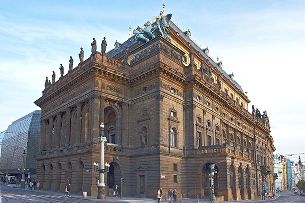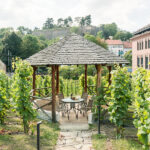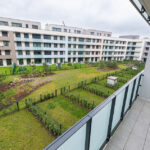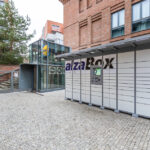There is no greater symbol of Czech patriotism than the National Theatre. The towering building on the banks of the Vltava River, opposite Hradčany, proves that. It’s not just an architectural gem: the theatre repertoire of all the three stages – drama, ballet and opera – has the hallmark of the highest quality. Every performance has a unique atmosphere and pomp. Even today, the National Theatre enjoys the respect of all generations.
Visit the “Golden Chapel” only in your best clothes
To wear jeans and a sweater for a performance in the National Theatre is a social faux pas. Although it’s increasingly common to go to the theatre in casual clothes, in the National Theatre, the old etiquette has remained the same. The magnificent exterior and interior of the building asks for it. Two and a half kilos of gold were used to gild its roof. That’s why the National Theatre is aptly called the “Golden Chapel”.
Fund-raising for the theatre
It took a year for the group of Czech patriots headed by František Palacký to make their idea to build a national theatre come true. In 1845, they finally got the privilege to “build, equip, maintain, and manage” an independent Czech theatre. But it took six years to organize charity collections the entire nation wanted to take part in. Everyone, the poor and the rich, the nobles, burghers and peasants made their contributions. The first money was used to buy the land opposite the magnificent panorama of the Prague Castle district, Hradčany.
Small patch: The Provisional Theatre
Bold plans were slowed down by Bach’s absolutism in the 1850s when senior officials had a great power. Therefore, the concept of a modest provisional scene on the south side of the plot, opened in 1862, prevailed. The outlines of the Provisional Theatre, which eventually became part of the magnificent National Theatre, are still visible in the increased part of the rear tract.
More than one foundation stone
The foundation stone of the current neo-Renaissance buildings was laid on 16 May 1868. Hundreds of thousands of people came to Prague to see the glory! However, there were more than one foundation stone from many counties and towns – probably 20 of them, although the exact number is a secret. According to historical documents, some stones were refused if they were related to the unfortunate moments in the Czech history, such as the stone from Přibyslav where Jan Žižka died.
A modest donor became a famous actress
All patriots wanted to help the National Theatre financially or with their skills. One of the first donors was little Otylka from Vienna and her brothers. The next year, she continued with her support, and organized charity performances in the country to send the proceeds to Prague. Later, it turned out the girl invested into her bright future, as well. Otylka – Otýlie Sklenářová-Malá – became one of the most famous actresses of her time. She started acting in the Provisional Theatre and took part in the first play put on the stage of the National Theatre in 1881. She was a member of the theatre company for more than 20 years.
How to get there
The building on the Vltava River bank, opposite the island of Žofín, can be easily reached on foot or by public transport. If you walk from the opposite river bank, walk through the Kampa Park or along the Střelecký Island under the Bridge of the Legions. If the weather is fine, you can rent a punt or a pedal boat. You can also go by tram and get off right next to the National Theatre. You can also go by underground – the yellow B line stop, Národní třída, is a five-minute walk towards the centre. And if you walk from Wenceslas Square, you can reach the National Theatre in ten minutes.
Guided tours of the historical building of the National Theatre can be arranged for both groups and individuals in many world languages.





